Singapore Port City Challenges and Opportunities
VerifiedAdded on 2020/05/28
|10
|1765
|124
AI Summary
This assignment examines the multifaceted landscape of Singapore's port city, highlighting both the hurdles and prospects it faces. It delves into challenges such as containerization pressures, rising operational costs, and environmental concerns. Conversely, it also explores opportunities arising from strategic partnerships, technological advancements, and the burgeoning maritime industry. The analysis aims to provide a comprehensive understanding of how Singapore can navigate these complexities to maintain its position as a leading global port city.
Contribute Materials
Your contribution can guide someone’s learning journey. Share your
documents today.
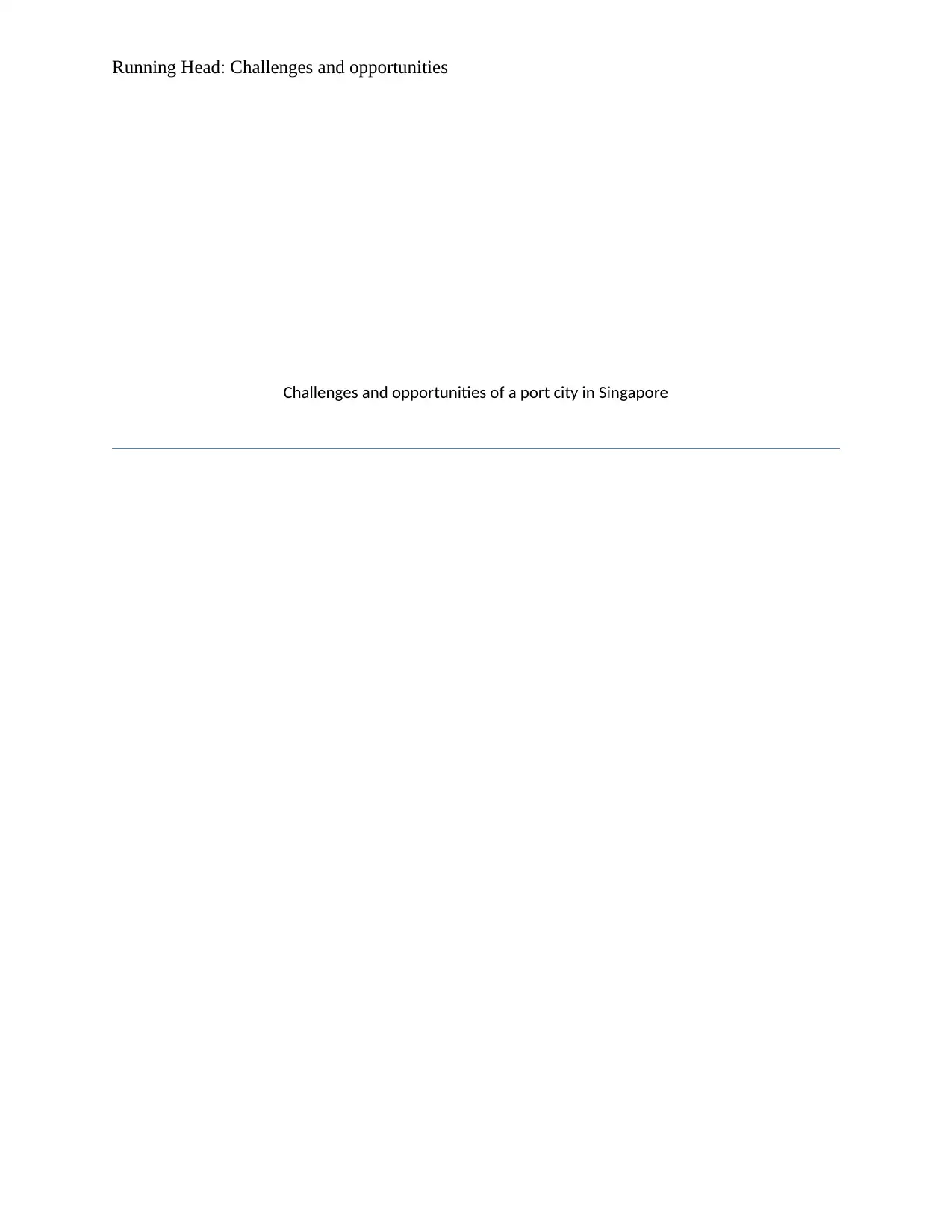
Running Head: Challenges and opportunities
Challenges and opportunities of a port city in Singapore
Challenges and opportunities of a port city in Singapore
Secure Best Marks with AI Grader
Need help grading? Try our AI Grader for instant feedback on your assignments.
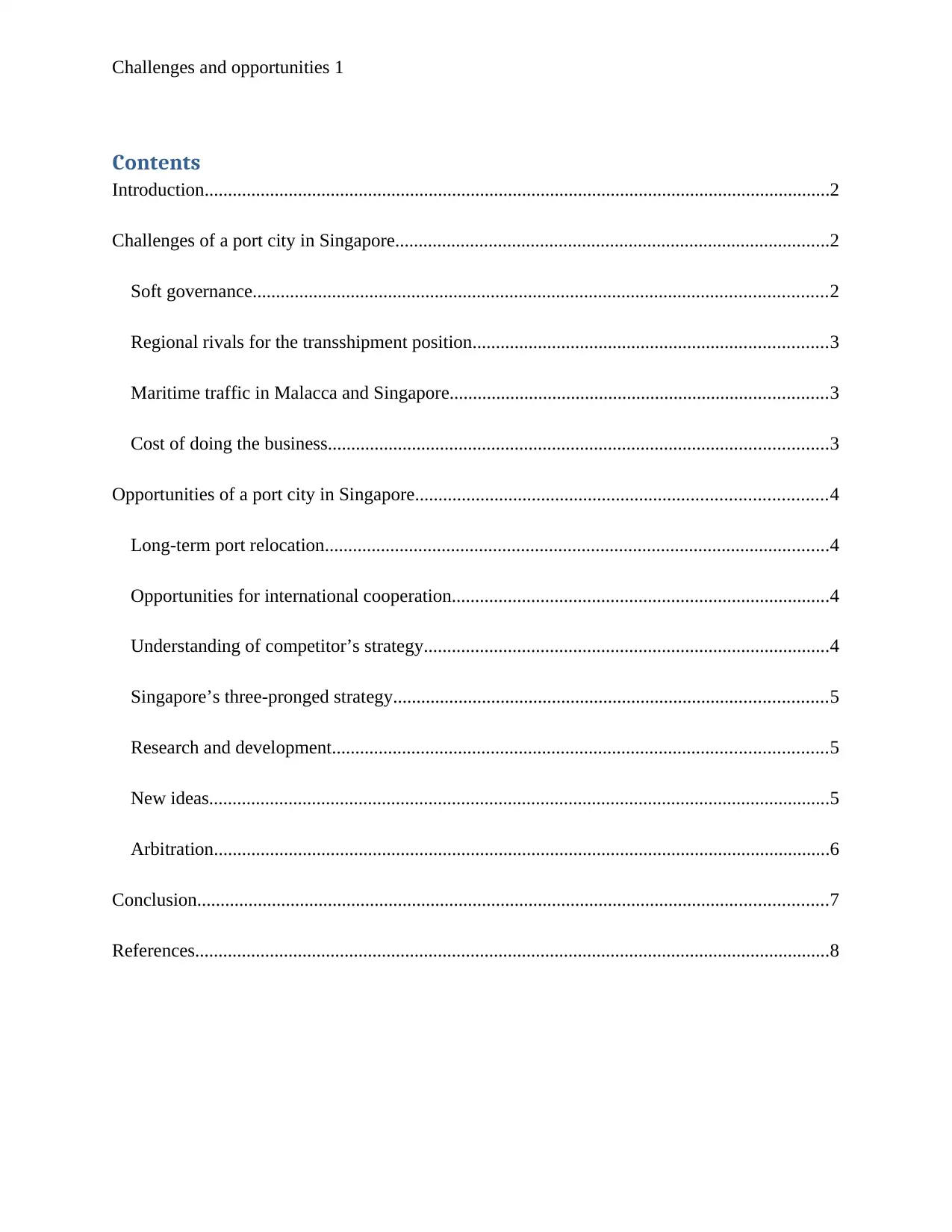
Challenges and opportunities 1
Contents
Introduction......................................................................................................................................2
Challenges of a port city in Singapore.............................................................................................2
Soft governance...........................................................................................................................2
Regional rivals for the transshipment position............................................................................3
Maritime traffic in Malacca and Singapore.................................................................................3
Cost of doing the business...........................................................................................................3
Opportunities of a port city in Singapore........................................................................................4
Long-term port relocation............................................................................................................4
Opportunities for international cooperation.................................................................................4
Understanding of competitor’s strategy.......................................................................................4
Singapore’s three-pronged strategy.............................................................................................5
Research and development..........................................................................................................5
New ideas.....................................................................................................................................5
Arbitration....................................................................................................................................6
Conclusion.......................................................................................................................................7
References........................................................................................................................................8
Contents
Introduction......................................................................................................................................2
Challenges of a port city in Singapore.............................................................................................2
Soft governance...........................................................................................................................2
Regional rivals for the transshipment position............................................................................3
Maritime traffic in Malacca and Singapore.................................................................................3
Cost of doing the business...........................................................................................................3
Opportunities of a port city in Singapore........................................................................................4
Long-term port relocation............................................................................................................4
Opportunities for international cooperation.................................................................................4
Understanding of competitor’s strategy.......................................................................................4
Singapore’s three-pronged strategy.............................................................................................5
Research and development..........................................................................................................5
New ideas.....................................................................................................................................5
Arbitration....................................................................................................................................6
Conclusion.......................................................................................................................................7
References........................................................................................................................................8
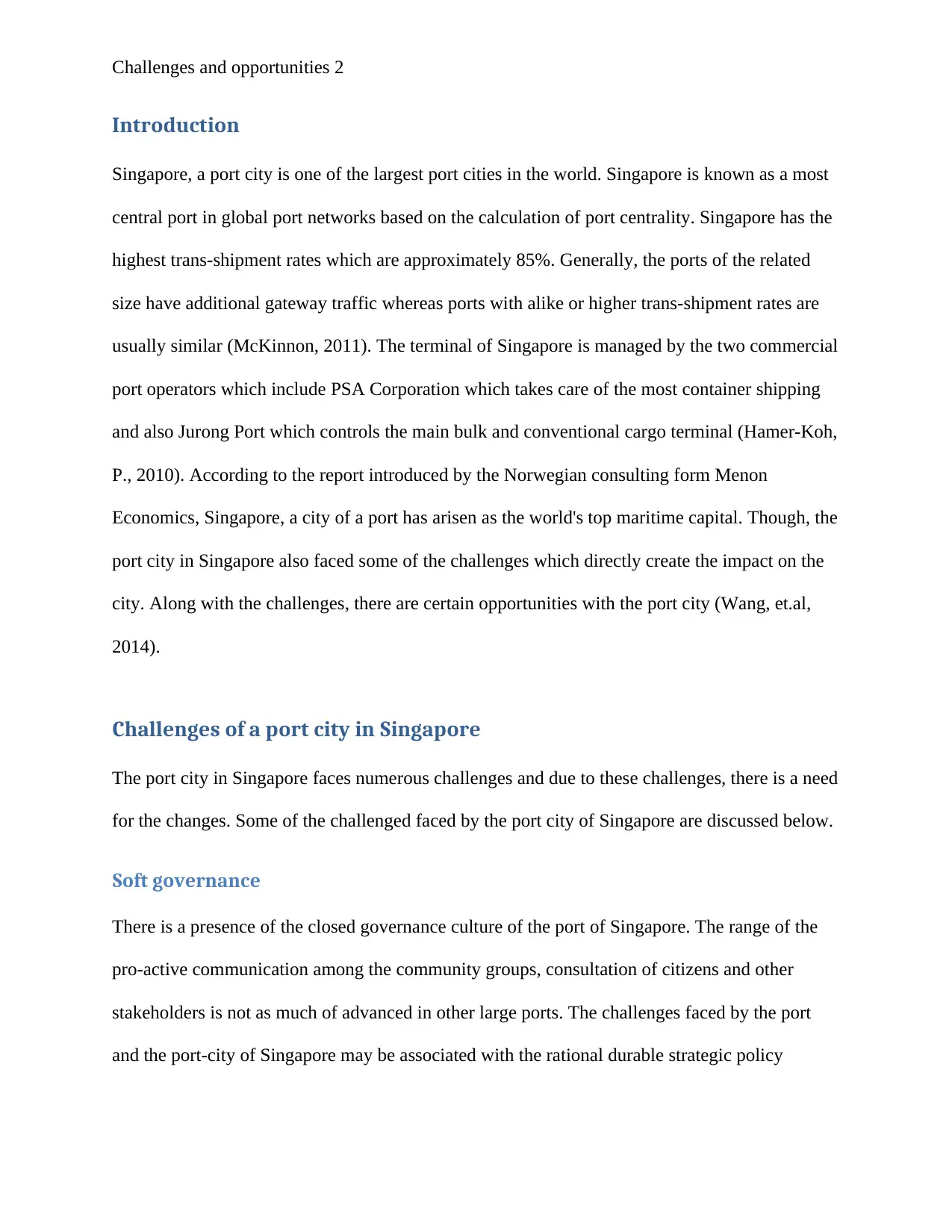
Challenges and opportunities 2
Introduction
Singapore, a port city is one of the largest port cities in the world. Singapore is known as a most
central port in global port networks based on the calculation of port centrality. Singapore has the
highest trans-shipment rates which are approximately 85%. Generally, the ports of the related
size have additional gateway traffic whereas ports with alike or higher trans-shipment rates are
usually similar (McKinnon, 2011). The terminal of Singapore is managed by the two commercial
port operators which include PSA Corporation which takes care of the most container shipping
and also Jurong Port which controls the main bulk and conventional cargo terminal (Hamer-Koh,
P., 2010). According to the report introduced by the Norwegian consulting form Menon
Economics, Singapore, a city of a port has arisen as the world's top maritime capital. Though, the
port city in Singapore also faced some of the challenges which directly create the impact on the
city. Along with the challenges, there are certain opportunities with the port city (Wang, et.al,
2014).
Challenges of a port city in Singapore
The port city in Singapore faces numerous challenges and due to these challenges, there is a need
for the changes. Some of the challenged faced by the port city of Singapore are discussed below.
Soft governance
There is a presence of the closed governance culture of the port of Singapore. The range of the
pro-active communication among the community groups, consultation of citizens and other
stakeholders is not as much of advanced in other large ports. The challenges faced by the port
and the port-city of Singapore may be associated with the rational durable strategic policy
Introduction
Singapore, a port city is one of the largest port cities in the world. Singapore is known as a most
central port in global port networks based on the calculation of port centrality. Singapore has the
highest trans-shipment rates which are approximately 85%. Generally, the ports of the related
size have additional gateway traffic whereas ports with alike or higher trans-shipment rates are
usually similar (McKinnon, 2011). The terminal of Singapore is managed by the two commercial
port operators which include PSA Corporation which takes care of the most container shipping
and also Jurong Port which controls the main bulk and conventional cargo terminal (Hamer-Koh,
P., 2010). According to the report introduced by the Norwegian consulting form Menon
Economics, Singapore, a city of a port has arisen as the world's top maritime capital. Though, the
port city in Singapore also faced some of the challenges which directly create the impact on the
city. Along with the challenges, there are certain opportunities with the port city (Wang, et.al,
2014).
Challenges of a port city in Singapore
The port city in Singapore faces numerous challenges and due to these challenges, there is a need
for the changes. Some of the challenged faced by the port city of Singapore are discussed below.
Soft governance
There is a presence of the closed governance culture of the port of Singapore. The range of the
pro-active communication among the community groups, consultation of citizens and other
stakeholders is not as much of advanced in other large ports. The challenges faced by the port
and the port-city of Singapore may be associated with the rational durable strategic policy
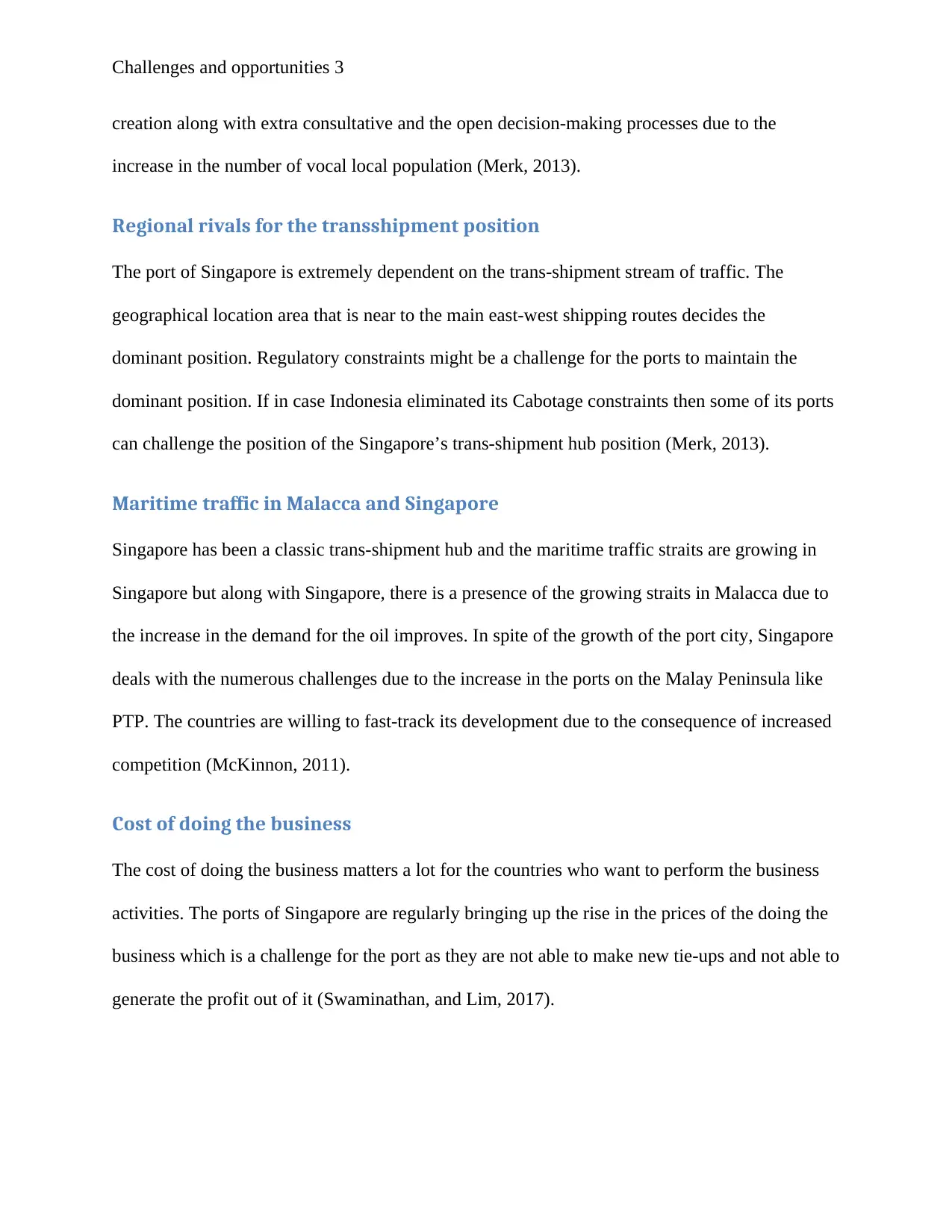
Challenges and opportunities 3
creation along with extra consultative and the open decision-making processes due to the
increase in the number of vocal local population (Merk, 2013).
Regional rivals for the transshipment position
The port of Singapore is extremely dependent on the trans-shipment stream of traffic. The
geographical location area that is near to the main east-west shipping routes decides the
dominant position. Regulatory constraints might be a challenge for the ports to maintain the
dominant position. If in case Indonesia eliminated its Cabotage constraints then some of its ports
can challenge the position of the Singapore’s trans-shipment hub position (Merk, 2013).
Maritime traffic in Malacca and Singapore
Singapore has been a classic trans-shipment hub and the maritime traffic straits are growing in
Singapore but along with Singapore, there is a presence of the growing straits in Malacca due to
the increase in the demand for the oil improves. In spite of the growth of the port city, Singapore
deals with the numerous challenges due to the increase in the ports on the Malay Peninsula like
PTP. The countries are willing to fast-track its development due to the consequence of increased
competition (McKinnon, 2011).
Cost of doing the business
The cost of doing the business matters a lot for the countries who want to perform the business
activities. The ports of Singapore are regularly bringing up the rise in the prices of the doing the
business which is a challenge for the port as they are not able to make new tie-ups and not able to
generate the profit out of it (Swaminathan, and Lim, 2017).
creation along with extra consultative and the open decision-making processes due to the
increase in the number of vocal local population (Merk, 2013).
Regional rivals for the transshipment position
The port of Singapore is extremely dependent on the trans-shipment stream of traffic. The
geographical location area that is near to the main east-west shipping routes decides the
dominant position. Regulatory constraints might be a challenge for the ports to maintain the
dominant position. If in case Indonesia eliminated its Cabotage constraints then some of its ports
can challenge the position of the Singapore’s trans-shipment hub position (Merk, 2013).
Maritime traffic in Malacca and Singapore
Singapore has been a classic trans-shipment hub and the maritime traffic straits are growing in
Singapore but along with Singapore, there is a presence of the growing straits in Malacca due to
the increase in the demand for the oil improves. In spite of the growth of the port city, Singapore
deals with the numerous challenges due to the increase in the ports on the Malay Peninsula like
PTP. The countries are willing to fast-track its development due to the consequence of increased
competition (McKinnon, 2011).
Cost of doing the business
The cost of doing the business matters a lot for the countries who want to perform the business
activities. The ports of Singapore are regularly bringing up the rise in the prices of the doing the
business which is a challenge for the port as they are not able to make new tie-ups and not able to
generate the profit out of it (Swaminathan, and Lim, 2017).
Secure Best Marks with AI Grader
Need help grading? Try our AI Grader for instant feedback on your assignments.
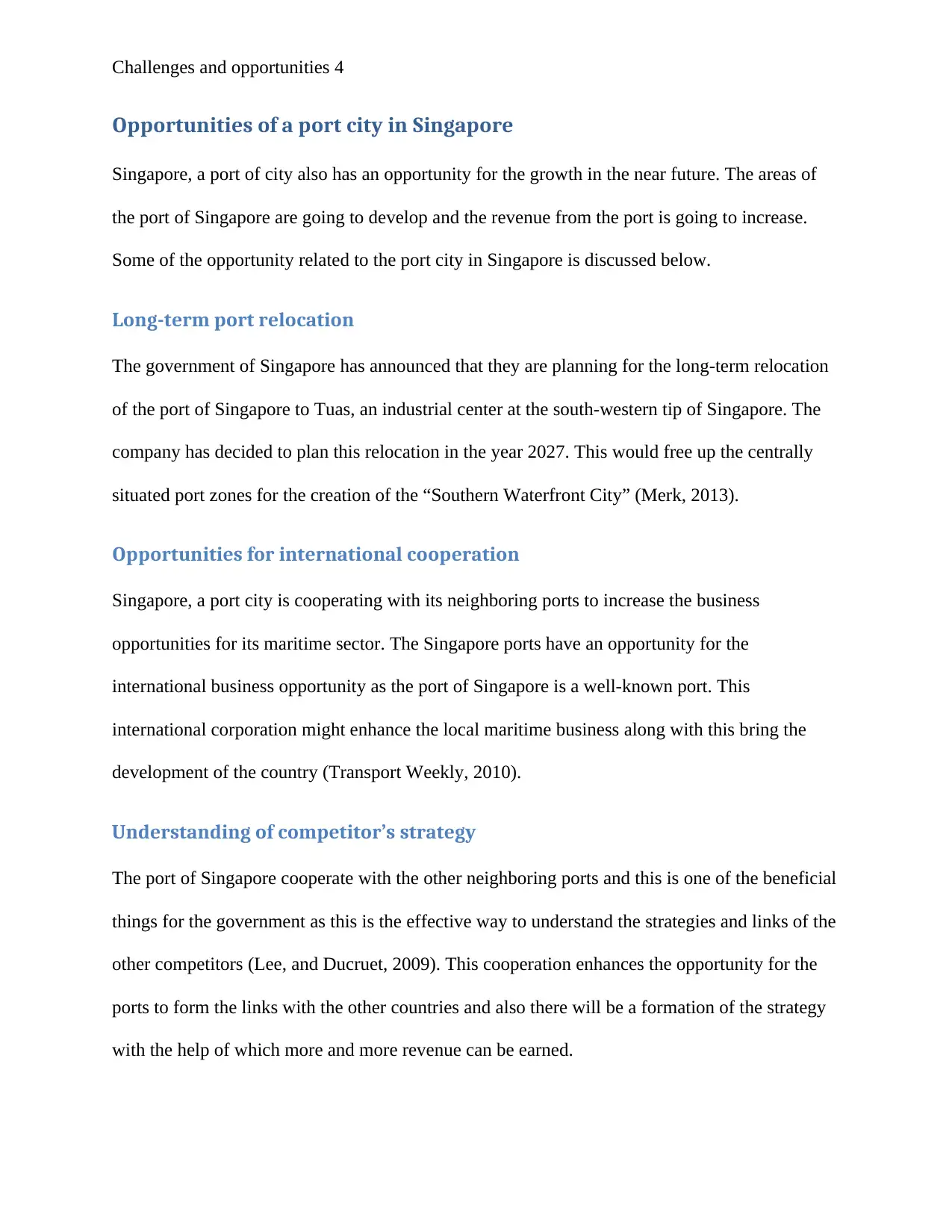
Challenges and opportunities 4
Opportunities of a port city in Singapore
Singapore, a port of city also has an opportunity for the growth in the near future. The areas of
the port of Singapore are going to develop and the revenue from the port is going to increase.
Some of the opportunity related to the port city in Singapore is discussed below.
Long-term port relocation
The government of Singapore has announced that they are planning for the long-term relocation
of the port of Singapore to Tuas, an industrial center at the south-western tip of Singapore. The
company has decided to plan this relocation in the year 2027. This would free up the centrally
situated port zones for the creation of the “Southern Waterfront City” (Merk, 2013).
Opportunities for international cooperation
Singapore, a port city is cooperating with its neighboring ports to increase the business
opportunities for its maritime sector. The Singapore ports have an opportunity for the
international business opportunity as the port of Singapore is a well-known port. This
international corporation might enhance the local maritime business along with this bring the
development of the country (Transport Weekly, 2010).
Understanding of competitor’s strategy
The port of Singapore cooperate with the other neighboring ports and this is one of the beneficial
things for the government as this is the effective way to understand the strategies and links of the
other competitors (Lee, and Ducruet, 2009). This cooperation enhances the opportunity for the
ports to form the links with the other countries and also there will be a formation of the strategy
with the help of which more and more revenue can be earned.
Opportunities of a port city in Singapore
Singapore, a port of city also has an opportunity for the growth in the near future. The areas of
the port of Singapore are going to develop and the revenue from the port is going to increase.
Some of the opportunity related to the port city in Singapore is discussed below.
Long-term port relocation
The government of Singapore has announced that they are planning for the long-term relocation
of the port of Singapore to Tuas, an industrial center at the south-western tip of Singapore. The
company has decided to plan this relocation in the year 2027. This would free up the centrally
situated port zones for the creation of the “Southern Waterfront City” (Merk, 2013).
Opportunities for international cooperation
Singapore, a port city is cooperating with its neighboring ports to increase the business
opportunities for its maritime sector. The Singapore ports have an opportunity for the
international business opportunity as the port of Singapore is a well-known port. This
international corporation might enhance the local maritime business along with this bring the
development of the country (Transport Weekly, 2010).
Understanding of competitor’s strategy
The port of Singapore cooperate with the other neighboring ports and this is one of the beneficial
things for the government as this is the effective way to understand the strategies and links of the
other competitors (Lee, and Ducruet, 2009). This cooperation enhances the opportunity for the
ports to form the links with the other countries and also there will be a formation of the strategy
with the help of which more and more revenue can be earned.
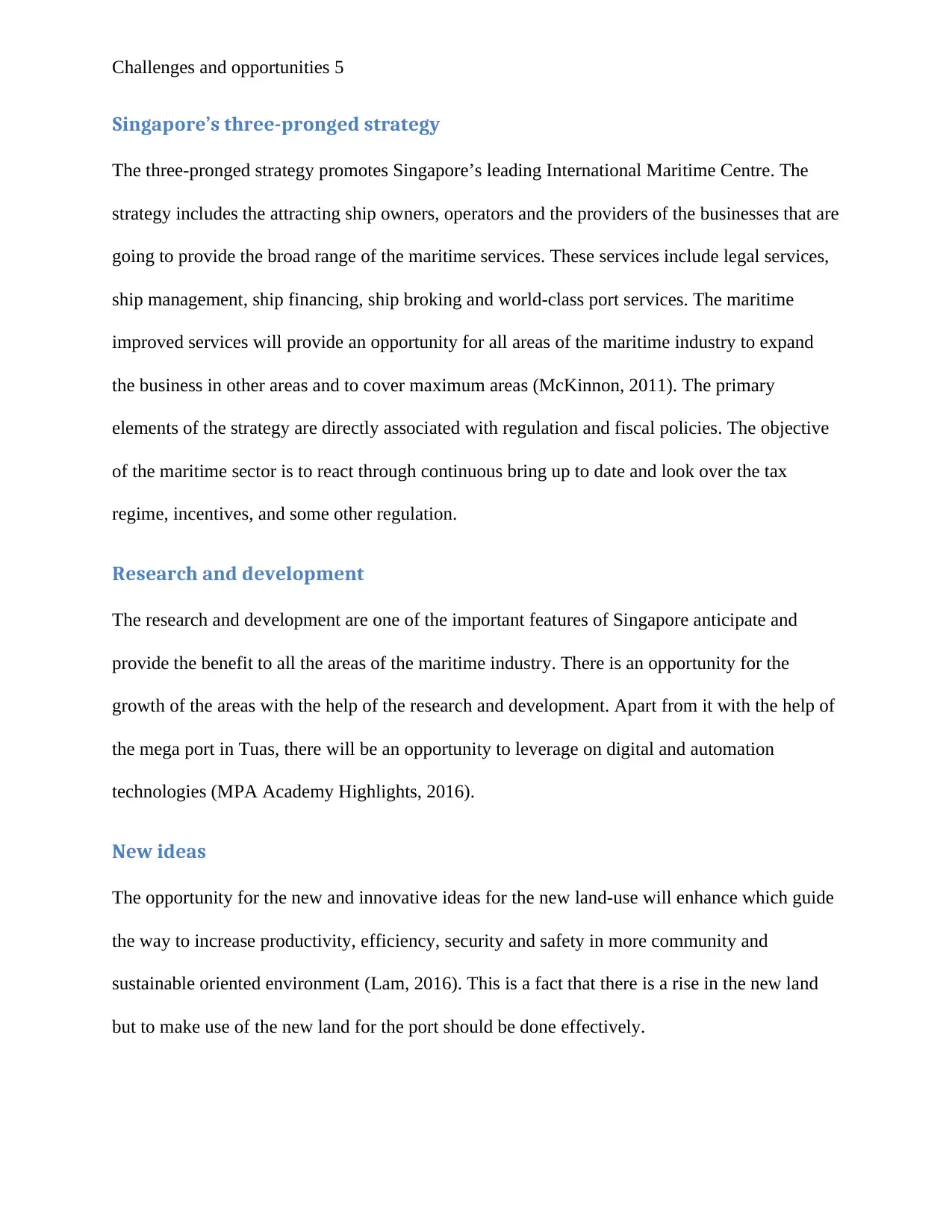
Challenges and opportunities 5
Singapore’s three-pronged strategy
The three-pronged strategy promotes Singapore’s leading International Maritime Centre. The
strategy includes the attracting ship owners, operators and the providers of the businesses that are
going to provide the broad range of the maritime services. These services include legal services,
ship management, ship financing, ship broking and world-class port services. The maritime
improved services will provide an opportunity for all areas of the maritime industry to expand
the business in other areas and to cover maximum areas (McKinnon, 2011). The primary
elements of the strategy are directly associated with regulation and fiscal policies. The objective
of the maritime sector is to react through continuous bring up to date and look over the tax
regime, incentives, and some other regulation.
Research and development
The research and development are one of the important features of Singapore anticipate and
provide the benefit to all the areas of the maritime industry. There is an opportunity for the
growth of the areas with the help of the research and development. Apart from it with the help of
the mega port in Tuas, there will be an opportunity to leverage on digital and automation
technologies (MPA Academy Highlights, 2016).
New ideas
The opportunity for the new and innovative ideas for the new land-use will enhance which guide
the way to increase productivity, efficiency, security and safety in more community and
sustainable oriented environment (Lam, 2016). This is a fact that there is a rise in the new land
but to make use of the new land for the port should be done effectively.
Singapore’s three-pronged strategy
The three-pronged strategy promotes Singapore’s leading International Maritime Centre. The
strategy includes the attracting ship owners, operators and the providers of the businesses that are
going to provide the broad range of the maritime services. These services include legal services,
ship management, ship financing, ship broking and world-class port services. The maritime
improved services will provide an opportunity for all areas of the maritime industry to expand
the business in other areas and to cover maximum areas (McKinnon, 2011). The primary
elements of the strategy are directly associated with regulation and fiscal policies. The objective
of the maritime sector is to react through continuous bring up to date and look over the tax
regime, incentives, and some other regulation.
Research and development
The research and development are one of the important features of Singapore anticipate and
provide the benefit to all the areas of the maritime industry. There is an opportunity for the
growth of the areas with the help of the research and development. Apart from it with the help of
the mega port in Tuas, there will be an opportunity to leverage on digital and automation
technologies (MPA Academy Highlights, 2016).
New ideas
The opportunity for the new and innovative ideas for the new land-use will enhance which guide
the way to increase productivity, efficiency, security and safety in more community and
sustainable oriented environment (Lam, 2016). This is a fact that there is a rise in the new land
but to make use of the new land for the port should be done effectively.
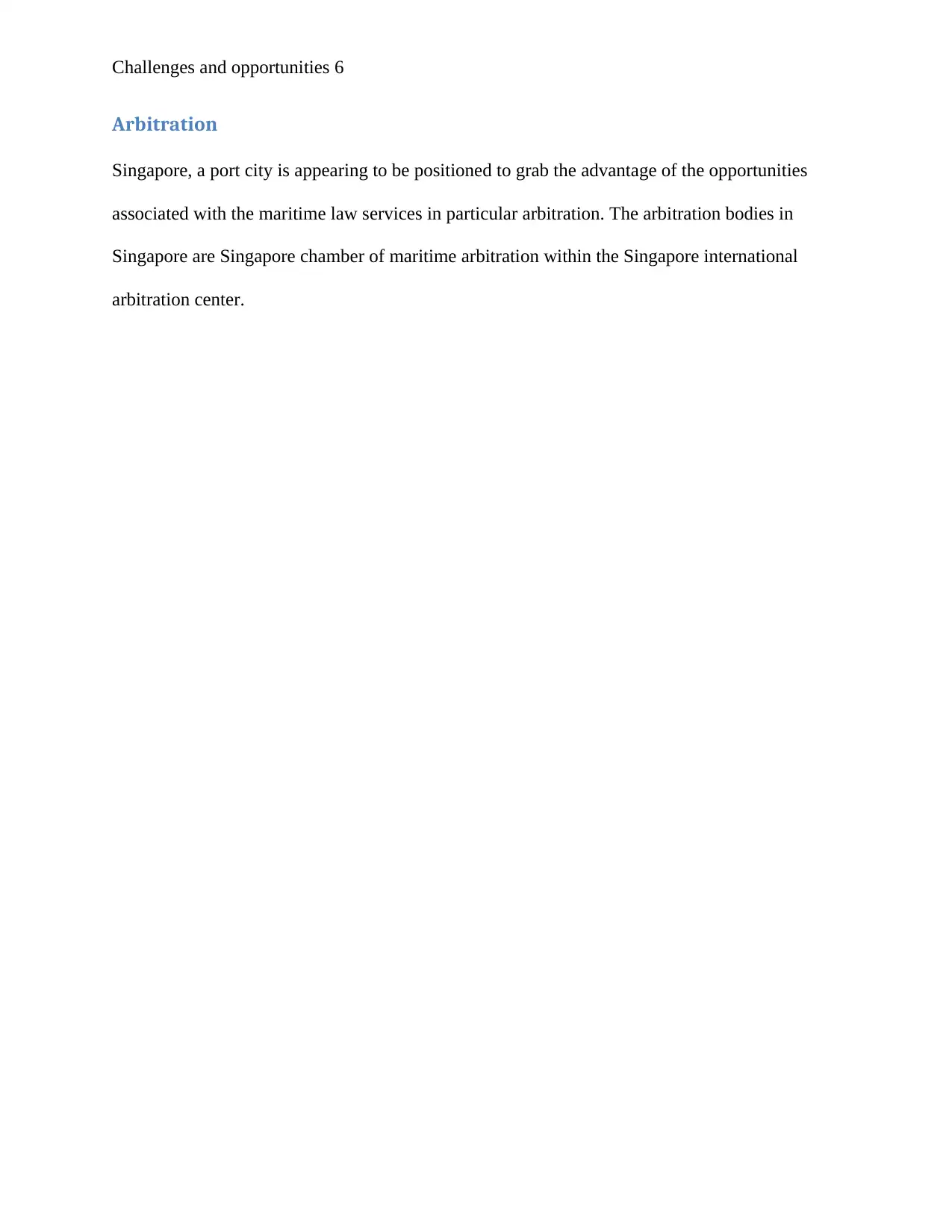
Challenges and opportunities 6
Arbitration
Singapore, a port city is appearing to be positioned to grab the advantage of the opportunities
associated with the maritime law services in particular arbitration. The arbitration bodies in
Singapore are Singapore chamber of maritime arbitration within the Singapore international
arbitration center.
Arbitration
Singapore, a port city is appearing to be positioned to grab the advantage of the opportunities
associated with the maritime law services in particular arbitration. The arbitration bodies in
Singapore are Singapore chamber of maritime arbitration within the Singapore international
arbitration center.
Paraphrase This Document
Need a fresh take? Get an instant paraphrase of this document with our AI Paraphraser
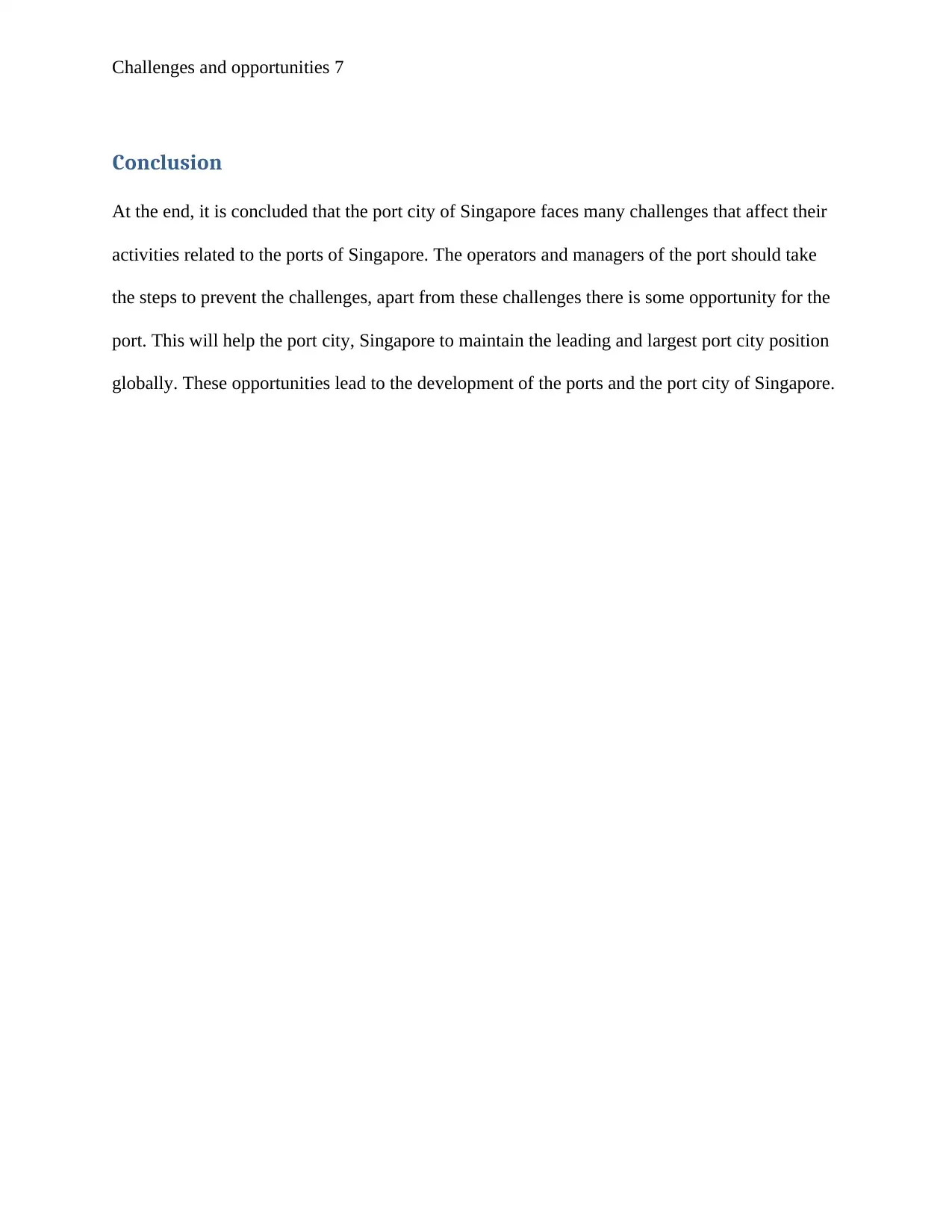
Challenges and opportunities 7
Conclusion
At the end, it is concluded that the port city of Singapore faces many challenges that affect their
activities related to the ports of Singapore. The operators and managers of the port should take
the steps to prevent the challenges, apart from these challenges there is some opportunity for the
port. This will help the port city, Singapore to maintain the leading and largest port city position
globally. These opportunities lead to the development of the ports and the port city of Singapore.
Conclusion
At the end, it is concluded that the port city of Singapore faces many challenges that affect their
activities related to the ports of Singapore. The operators and managers of the port should take
the steps to prevent the challenges, apart from these challenges there is some opportunity for the
port. This will help the port city, Singapore to maintain the leading and largest port city position
globally. These opportunities lead to the development of the ports and the port city of Singapore.
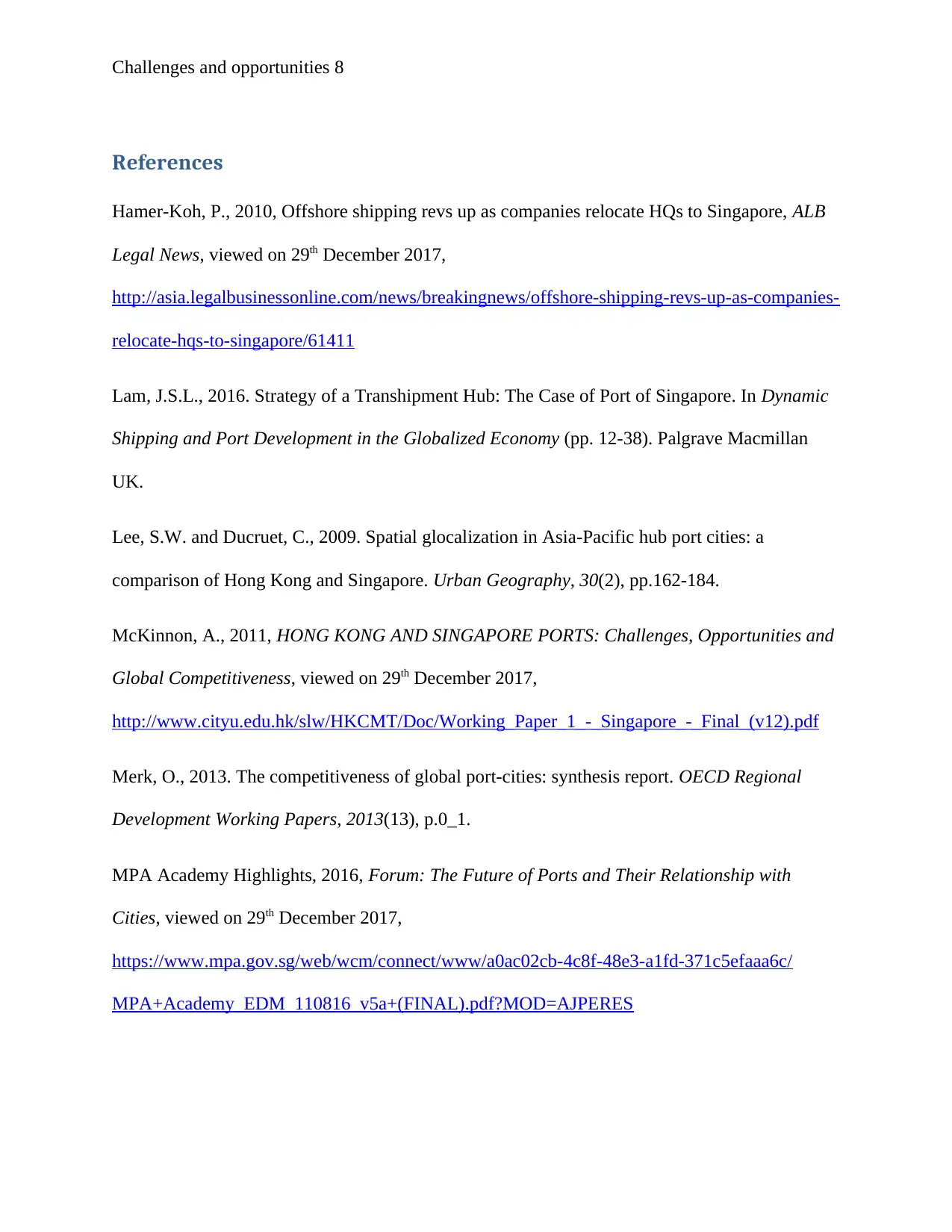
Challenges and opportunities 8
References
Hamer-Koh, P., 2010, Offshore shipping revs up as companies relocate HQs to Singapore, ALB
Legal News, viewed on 29th December 2017,
http://asia.legalbusinessonline.com/news/breakingnews/offshore-shipping-revs-up-as-companies-
relocate-hqs-to-singapore/61411
Lam, J.S.L., 2016. Strategy of a Transhipment Hub: The Case of Port of Singapore. In Dynamic
Shipping and Port Development in the Globalized Economy (pp. 12-38). Palgrave Macmillan
UK.
Lee, S.W. and Ducruet, C., 2009. Spatial glocalization in Asia-Pacific hub port cities: a
comparison of Hong Kong and Singapore. Urban Geography, 30(2), pp.162-184.
McKinnon, A., 2011, HONG KONG AND SINGAPORE PORTS: Challenges, Opportunities and
Global Competitiveness, viewed on 29th December 2017,
http://www.cityu.edu.hk/slw/HKCMT/Doc/Working_Paper_1_-_Singapore_-_Final_(v12).pdf
Merk, O., 2013. The competitiveness of global port-cities: synthesis report. OECD Regional
Development Working Papers, 2013(13), p.0_1.
MPA Academy Highlights, 2016, Forum: The Future of Ports and Their Relationship with
Cities, viewed on 29th December 2017,
https://www.mpa.gov.sg/web/wcm/connect/www/a0ac02cb-4c8f-48e3-a1fd-371c5efaaa6c/
MPA+Academy_EDM_110816_v5a+(FINAL).pdf?MOD=AJPERES
References
Hamer-Koh, P., 2010, Offshore shipping revs up as companies relocate HQs to Singapore, ALB
Legal News, viewed on 29th December 2017,
http://asia.legalbusinessonline.com/news/breakingnews/offshore-shipping-revs-up-as-companies-
relocate-hqs-to-singapore/61411
Lam, J.S.L., 2016. Strategy of a Transhipment Hub: The Case of Port of Singapore. In Dynamic
Shipping and Port Development in the Globalized Economy (pp. 12-38). Palgrave Macmillan
UK.
Lee, S.W. and Ducruet, C., 2009. Spatial glocalization in Asia-Pacific hub port cities: a
comparison of Hong Kong and Singapore. Urban Geography, 30(2), pp.162-184.
McKinnon, A., 2011, HONG KONG AND SINGAPORE PORTS: Challenges, Opportunities and
Global Competitiveness, viewed on 29th December 2017,
http://www.cityu.edu.hk/slw/HKCMT/Doc/Working_Paper_1_-_Singapore_-_Final_(v12).pdf
Merk, O., 2013. The competitiveness of global port-cities: synthesis report. OECD Regional
Development Working Papers, 2013(13), p.0_1.
MPA Academy Highlights, 2016, Forum: The Future of Ports and Their Relationship with
Cities, viewed on 29th December 2017,
https://www.mpa.gov.sg/web/wcm/connect/www/a0ac02cb-4c8f-48e3-a1fd-371c5efaaa6c/
MPA+Academy_EDM_110816_v5a+(FINAL).pdf?MOD=AJPERES
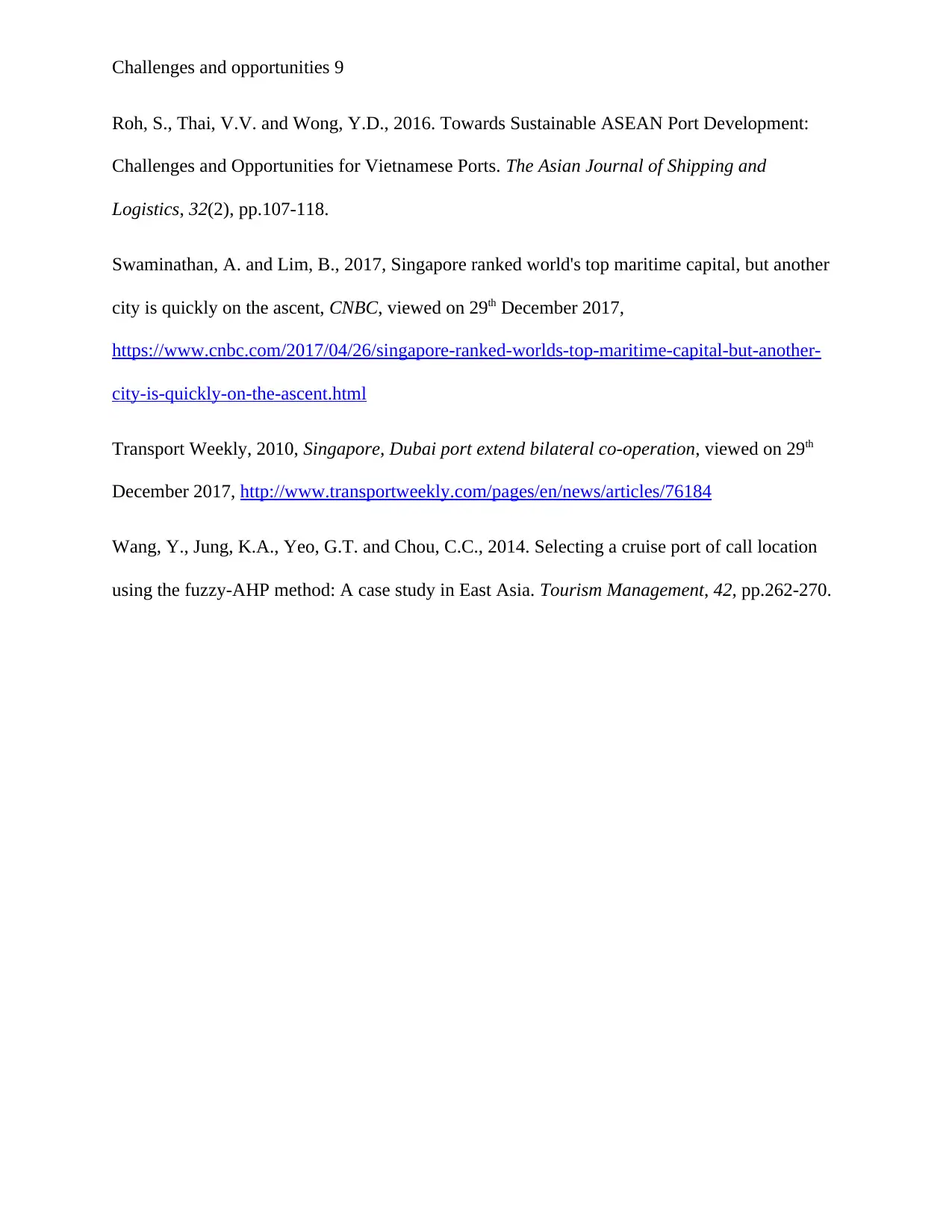
Challenges and opportunities 9
Roh, S., Thai, V.V. and Wong, Y.D., 2016. Towards Sustainable ASEAN Port Development:
Challenges and Opportunities for Vietnamese Ports. The Asian Journal of Shipping and
Logistics, 32(2), pp.107-118.
Swaminathan, A. and Lim, B., 2017, Singapore ranked world's top maritime capital, but another
city is quickly on the ascent, CNBC, viewed on 29th December 2017,
https://www.cnbc.com/2017/04/26/singapore-ranked-worlds-top-maritime-capital-but-another-
city-is-quickly-on-the-ascent.html
Transport Weekly, 2010, Singapore, Dubai port extend bilateral co-operation, viewed on 29th
December 2017, http://www.transportweekly.com/pages/en/news/articles/76184
Wang, Y., Jung, K.A., Yeo, G.T. and Chou, C.C., 2014. Selecting a cruise port of call location
using the fuzzy-AHP method: A case study in East Asia. Tourism Management, 42, pp.262-270.
Roh, S., Thai, V.V. and Wong, Y.D., 2016. Towards Sustainable ASEAN Port Development:
Challenges and Opportunities for Vietnamese Ports. The Asian Journal of Shipping and
Logistics, 32(2), pp.107-118.
Swaminathan, A. and Lim, B., 2017, Singapore ranked world's top maritime capital, but another
city is quickly on the ascent, CNBC, viewed on 29th December 2017,
https://www.cnbc.com/2017/04/26/singapore-ranked-worlds-top-maritime-capital-but-another-
city-is-quickly-on-the-ascent.html
Transport Weekly, 2010, Singapore, Dubai port extend bilateral co-operation, viewed on 29th
December 2017, http://www.transportweekly.com/pages/en/news/articles/76184
Wang, Y., Jung, K.A., Yeo, G.T. and Chou, C.C., 2014. Selecting a cruise port of call location
using the fuzzy-AHP method: A case study in East Asia. Tourism Management, 42, pp.262-270.
1 out of 10
Your All-in-One AI-Powered Toolkit for Academic Success.
+13062052269
info@desklib.com
Available 24*7 on WhatsApp / Email
![[object Object]](/_next/static/media/star-bottom.7253800d.svg)
Unlock your academic potential
© 2024 | Zucol Services PVT LTD | All rights reserved.